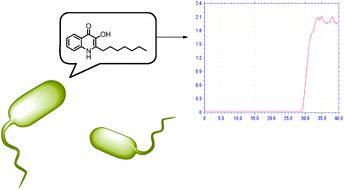Detection of the Pseudomonas Quinolone Signal (PQS) by cyclic voltammetry and amperometry using a boron doped diamond electrode†
Abstract

* Corresponding authors
a Innovative chromatography Group, Irish Separation Science Cluster (ISSC), University College Cork, Ireland
b
Department of Chemistry and Analytical and Biological Research Facility, University College Cork, Ireland
E-mail:
g.mcglacken@ucc.ie
Fax: +353 (0)214902866
c National Research Council Canada, Biotechnology Research Institute, Montreal, Quebec, Canada
d BIOMERIT Research Centre, Department of Microbiology, University College Cork, Ireland

 Please wait while we load your content...
Something went wrong. Try again?
Please wait while we load your content...
Something went wrong. Try again?
L. Zhou, J. D. Glennon, J. H. T. Luong, F. J. Reen, F. O'Gara, C. McSweeney and G. P. McGlacken, Chem. Commun., 2011, 47, 10347 DOI: 10.1039/C1CC13997E
To request permission to reproduce material from this article, please go to the Copyright Clearance Center request page.
If you are an author contributing to an RSC publication, you do not need to request permission provided correct acknowledgement is given.
If you are the author of this article, you do not need to request permission to reproduce figures and diagrams provided correct acknowledgement is given. If you want to reproduce the whole article in a third-party publication (excluding your thesis/dissertation for which permission is not required) please go to the Copyright Clearance Center request page.
Read more about how to correctly acknowledge RSC content.
 Fetching data from CrossRef.
Fetching data from CrossRef.
This may take some time to load.
Loading related content
